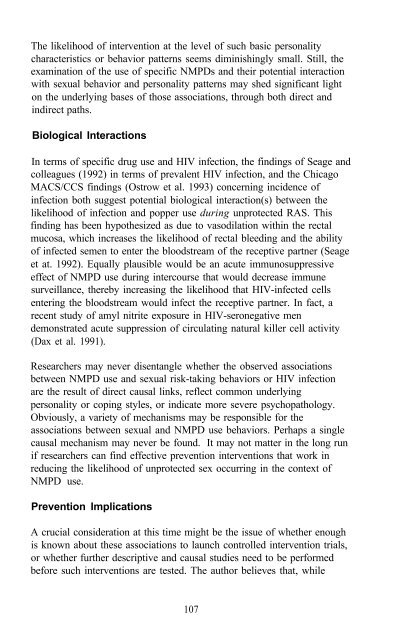The Context of HIV Risk Among Drug Users and Their Sexual Partners
The Context of HIV Risk Among Drug Users and Their Sexual Partners
The Context of HIV Risk Among Drug Users and Their Sexual Partners
You also want an ePaper? Increase the reach of your titles
YUMPU automatically turns print PDFs into web optimized ePapers that Google loves.
<strong>The</strong> likelihood <strong>of</strong> intervention at the level <strong>of</strong> such basic personality<br />
characteristics or behavior patterns seems diminishingly small. Still, the<br />
examination <strong>of</strong> the use <strong>of</strong> specific NMPDs <strong>and</strong> their potential interaction<br />
with sexual behavior <strong>and</strong> personality patterns may shed significant light<br />
on the underlying bases <strong>of</strong> those associations, through both direct <strong>and</strong><br />
indirect paths.<br />
Biological Interactions<br />
In terms <strong>of</strong> specific drug use <strong>and</strong> <strong>HIV</strong> infection, the findings <strong>of</strong> Seage <strong>and</strong><br />
colleagues (1992) in terms <strong>of</strong> prevalent <strong>HIV</strong> infection, <strong>and</strong> the Chicago<br />
MACS/CCS findings (Ostrow et al. 1993) concerning incidence <strong>of</strong><br />
infection both suggest potential biological interaction(s) between the<br />
likelihood <strong>of</strong> infection <strong>and</strong> popper use during unprotected RAS. This<br />
finding has been hypothesized as due to vasodilation within the rectal<br />
mucosa, which increases the likelihood <strong>of</strong> rectal bleeding <strong>and</strong> the ability<br />
<strong>of</strong> infected semen to enter the bloodstream <strong>of</strong> the receptive partner (Seage<br />
et at. 1992). Equally plausible would be an acute immunosuppressive<br />
effect <strong>of</strong> NMPD use during intercourse that would decrease immune<br />
surveillance, thereby increasing the likelihood that <strong>HIV</strong>-infected cells<br />
entering the bloodstream would infect the receptive partner. In fact, a<br />
recent study <strong>of</strong> amyl nitrite exposure in <strong>HIV</strong>-seronegative men<br />
demonstrated acute suppression <strong>of</strong> circulating natural killer cell activity<br />
(Dax et al. 1991).<br />
Researchers may never disentangle whether the observed associations<br />
between NMPD use <strong>and</strong> sexual risk-taking behaviors or <strong>HIV</strong> infection<br />
are the result <strong>of</strong> direct causal links, reflect common underlying<br />
personality or coping styles, or indicate more severe psychopathology.<br />
Obviously, a variety <strong>of</strong> mechanisms may be responsible for the<br />
associations between sexual <strong>and</strong> NMPD use behaviors. Perhaps a single<br />
causal mechanism may never be found. It may not matter in the long run<br />
if researchers can find effective prevention interventions that work in<br />
reducing the likelihood <strong>of</strong> unprotected sex occurring in the context <strong>of</strong><br />
NMPD use.<br />
Prevention Implications<br />
A crucial consideration at this time might be the issue <strong>of</strong> whether enough<br />
is known about these associations to launch controlled intervention trials,<br />
or whether further descriptive <strong>and</strong> causal studies need to be performed<br />
before such interventions are tested. <strong>The</strong> author believes that, while<br />
107
















